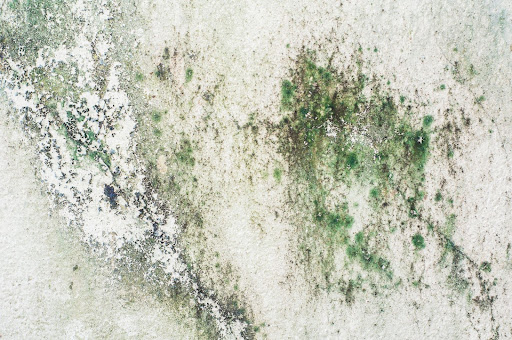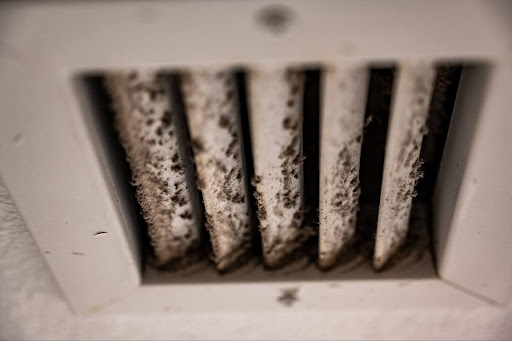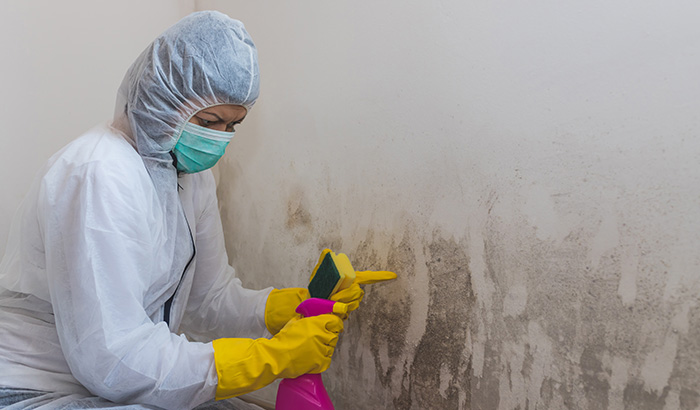Mold is common in homes, but it often lurks in secret — necessitating prompt and effective mold remediation to ensure a healthy living environment.
With a never-ending household task list, mold is often the last thing on a homeowner’s mind. Mold damage often infiltrates homes invisibly, only making itself known when it escalates into a giant problem. But don’t worry, this detailed guide will protect you against its assault!
Today, we’re diving into the unpleasant realm of mold damage, from its sources and symptoms to preventative and treatment methods.
What is mold?
Molds are a natural part of the environment and can grow anywhere there is moisture. Mold spores multiply and develop on diverse surfaces that are damp and humid. Although mold is necessary for nature’s ecosystem, it becomes a hazard when it makes itself at home inside your living space.
Indoor mold growth is unsettling, unattractive, and sometimes dangerous. Mold can develop in walls, under floors, in the HVAC system, or anywhere damp enough to be inviting. It can cause dangerous allergic responses, asthma episodes, and irritation in the eyes, skin, nose, throat, and lungs. Because of its risks, prompt mold inspection and remediation are essential to protect your health.
Here are 10 signs of mold to keep an eye out for:
1. Discoloration
Mold can affect the color of the places where it grows. Discoloration is the most visible indicator of mold, and it occurs when the mold feeds on a surface.
When mold begins to spread and expand, it gives materials black, gray, white, brown, red, or even pastel colors. Some molds appear fuzzy or hazy, while others resemble sand particles. Any sudden discoloration is a potential red flag to note.

2. Squishy floors
Moisture issues in your subfloor may cause certain areas to feel mushy, indicating that mold might be developing. If you cannot readily reach your subfloor, lift portions of your flooring to inspect for mold development. A licensed mold removal professional can remove the mold and perform complete mold infestation removal.
3. Water leaks
Mold development is expected in areas with standing water, steady leaks, or any other area where water gets into a building. Water can enter a home through a variety of ways, including damaged roof shingles, leaking pipes, floods, storms, dripping faucets, and leaky toilets. When the water has nowhere productive to end up, it causes rot, which inevitably leads to mold development.
4. Water damage
Mold and moisture go hand in hand — mold cannot develop without moisture. So, if your home suffers water damage, don’t delay!
First, find the cause of the water damage. If there was a flood, you should contact a mold treatment business in your area. In some circumstances, however, you may need to conduct more research. If you have water stains on your ceiling or water on your kitchen floor, you’ll need to determine the source.
Whatever the cause, quick action is critical. Mold will swiftly develop and spread if left alone. If the conditions are right, mold will begin to grow as soon as 24 to 48 hours after water damage, so don’t delay in scheduling a mold inspection after water damage.
5. Stagnant air
Checking airflow is another approach to detect the presence of mold. Mold colonies will thrive best in a room lacking adequate ventilation. Without proper ventilation, water cannot evaporate and exit the home.
Attics are an example of rooms with limited ventilation that are at high risk for needing mold removal. Another area of your home that often doesn’t receive proper ventilation is the basement, so inspect that area as well. Ventilation issues may also arise in restrooms and toilets that lack exhaust fans.
6. Strange smells
Certain molds emit an odor as they spread. Although some kinds do not produce smells at all, a musty smell often indicates a mold problem or some other issue. Even if you haven’t seen mold, any unidentifiable smell warrants investigation.
Odor shouldn’t be the only factor considering mold remediation. Some fungal species that are actively colonizing emit smells. Dead or dormant spores, on the other hand, are just as dangerous to human health. The absence of odor does not imply the absence of mold, nor does odor always mean that there is fungal development. Do not rely simply on fragrance to recognize a threat.
7. Previous mold history
If you’ve had a mold problem in the past that wasn’t properly addressed, there’s a good chance it’ll come back. Mold spreads by spores and lays dormant until conditions are right for development. If you have a history of mold problems, it’s critical that you take preventative measures and seek expert mold removal and restoration services.
8. Peeling wallpaper
When water soaks into your drywall, it softens and compromises the wallpaper or paint. Paint splits and wallpaper peels because of this. The unfortunate issue is that it will take some time for your wall to exhibit signs of damage. Mold development has reached an advanced stage at this point.
Allowing sunshine to penetrate dry walls is a wonderful method to dry them out; however, if the damage has already deteriorated, it may endanger the structural integrity of your property. This is when you will want a mold inspection by a professional.
9. Cold symptoms
Wintertime colds run rampant through families each year. Most of the time, the sickness comes from viruses, but it occasionally comes from another source. Exposure to mold usually has similar symptoms to a common cold. Individuals who are sensitive to it may have symptoms such as wheezing, red eyes, a stuffy nose, and itchy eyes or skin, according to the Centers for Disease Control and Prevention (CDC).
Even if you don’t notice mold on the walls, you might be exposed to mold and become unwell as a result. Mold spores spread easily throughout your home if the mold is inside your air vents or HVAC system. Inhaling these spores results in mold-related respiratory problems, so always check air ducts during a mold inspection.
There is no doctor-recommended health test to determine mold exposure. The best technique to determine mold responses is to observe if symptoms disappear when people leave the residence. If this is the case, it’s worth checking whether mold removal is necessary.

10. Health symptoms in your pets
Inappropriate pet behavior or illness is another sign of mold exposure. Often, the first sign an animal is sick is changed behavior. Aside from this, mold has a similar effect on pets as it does on humans.
Because of variations in body size and immune systems, pets are significantly more vulnerable to indoor mold than humans. Tiredness, difficulty breathing, coughing, wheezing, vomiting, and loss of appetite are all possible symptoms. Mold allergies in cats cause itchy, swelling, or irritated skin, as well as hair loss.
When should I start mold remediation?
Mold will continue to develop if left untreated, especially if it’s lurking in hidden regions. Mold spreads fast, so act as soon as you see a problem. Waiting too long to handle mold results in health risks for building occupants, damage to furniture or equipment, and other difficulties. Using specialized materials and equipment and working with a professional are the best methods to ensure proper mold removal.
How long does mold remediation take?
The severity of the mold infestation affects how long mold remediation will take. Another consideration is the location of the mold. Mold eradication may take longer if it is in difficult-to-reach regions, such as inside walls or ducts.
Professional mold cleaning often takes 1 to 5 days. Professionals must locate the mold, treat the affected area, and provide enough time for the treatments to be successful. They must also test to determine that the therapy was effective and reapply if necessary.
How to prevent mold
After mold remediation, there are several things you can do to help reduce the impact of mold in your house. They are as follows:
- Remove visible mold.
- Monitor humidity levels.
- Maintain proper ventilation.
- Inspect and repair roof gutters.
- Ensure proper ground slope.
- Use a vacuum cleaner with a functional filter.
- Keep moist spaces like the bathroom and kitchen dry.
- Use exhaust fans or open windows in the kitchen and bathroom when showering, cooking, or using the dishwasher.
- Repair leaking pipes and other structural flaws promptly.
As with most things, prevention is better than remediation. Prevention helps save a lot of time and money in the long run.
Reach out to Black Diamond Water Damage & Restoration for the best mold remediation in Utah
Black Diamond Restoration is a market leader in mold remediation in Utah. You can rely on our qualified specialists to complete the task swiftly and efficiently. We provide complete, professional services to both households and companies. We are the firm to call if your property has been affected by pesky mold growth that won’t go away.
If you require mold mitigation, contact Black Diamond Water Damage & Disaster Restoration right away! We’ll quickly restore your life and living space to normalcy.
toto slot






